 Some people lose their heads over weddings, and no more so than in Japan, where the average ceremony costs around $30,000 U.S., and involves about 75 guests (probably many more for the reception.)There are 4 main types of wedding ceremonies here. Listed in order of popularity they are: chapel weddings (aka white wedding,) Shinto style, civil, and Buddhist. None of these ceremonies has anything to do with being married legally, they’re just ceremonies. The only legal wedding in Japan is when a couple (still limited to men and women) decides to register themselves as married in the local Family Register, which is a register of things like births and deaths, family members, and marriages. To get married legally, the couple requests a form from the local government office which is much like a marriage license in the west, has it signed by two witnesses, and then returns it to the local government office. This is their request to be entered into the Family Register as married. Depending on the location and circumstances, there may be a few more documents required, but when all the red tape is wrapped, the government issues a certificate that the couple’s request has been granted and they are registered as husband and wife.
Some people lose their heads over weddings, and no more so than in Japan, where the average ceremony costs around $30,000 U.S., and involves about 75 guests (probably many more for the reception.)There are 4 main types of wedding ceremonies here. Listed in order of popularity they are: chapel weddings (aka white wedding,) Shinto style, civil, and Buddhist. None of these ceremonies has anything to do with being married legally, they’re just ceremonies. The only legal wedding in Japan is when a couple (still limited to men and women) decides to register themselves as married in the local Family Register, which is a register of things like births and deaths, family members, and marriages. To get married legally, the couple requests a form from the local government office which is much like a marriage license in the west, has it signed by two witnesses, and then returns it to the local government office. This is their request to be entered into the Family Register as married. Depending on the location and circumstances, there may be a few more documents required, but when all the red tape is wrapped, the government issues a certificate that the couple’s request has been granted and they are registered as husband and wife.
Ceremonies are just that — ceremonies. If you search for Japanese weddings, you’re likely to find a lot of talk about “fake” wedding pastors, which seems a little silly for a strictly ceremonial ceremony, not to put too fine a point on it. The types of ceremonies are called “shin zen shiki” [神前式] where shin means god, zen means in front of, and shiki means ceremony; this is the Shinto wedding, and “fake” priests also perform these ceremonies during rush times. “Jin zen shiki” [人前式] is like shin zen shiki except it’s in front of people (jin) so it’s a civil wedding. Since some 99% of Japanese are not Christian, there’s some confusion on what to call weddings modeled on the Christian style (where the fake pastors lurk) though chapel wedding seems to be most popular now. There are still places that call them Christian weddings and white weddings. Buddhist weddings do happen, but seem to be extremely rare. In 30 years here, the only Buddhist wedding I’ve attended, or even heard of, was for the son of a temple priest.
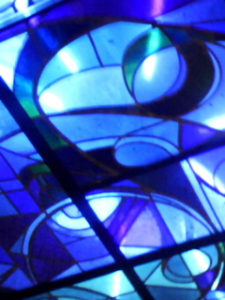
stained glass ceiling
Due to the fact that there are so few Christians in Japan, you might wonder how a Christian style wedding got to be the most popular type here. Most accounts credit it to the wedding of Princess Diana, a real princess and extremely popular worldwide, and the televised 1980 wedding of Momoe Yamaguchi, one of the most successful Japanese singers who is often referred to as the pop princess of the 1970’s. The Christian wedding here is a testament to the Japanese ability to adopt and adapt foreign ideas. Stereotypical icons like rosary beads, crosses (though not crucifixes,) stained glass, statues of angels, and beautiful antique, leather bound bibles are frequent decorations, while uniquely Japanese touches like the “virgin road” and “first meet” and changes of clothes for the reception are now ubiquitous. A popular 1997 TV miniseries was called Virgin Road and featured the most recent Japanese pop princess, Namie Amuro, in the opening sequence. Naturally set in a chapel, the opening featured the hit song, “Can You Celebrate” which is still requested sometimes for the bride’s entrance. Virgin road has become the mandatory label for the center aisle at chapels, and is so common even foreign pastors seem to believe it has some real basis in the English language; it doesn’t.
These days wedding halls with a room for a Shinto style ceremony and a chapel, as well as photo studio, hair and makeup salons, large ballrooms, and shuttle busses to local train stations and hotels, compete with the larger hotels for the wedding business. Most places use their own staff for planning and banquets, but use contractors for flowers and videos and musicians and celebrants, fake or not. While these large venues have the majority of weddings, restaurants do host ceremonies occasionally. Unlike the west, home and garden style weddings are really rare. Chapels at most places are conveniently equipped with portable Christian icons that can be easily removed to accommodate civil weddings, though some have to go to considerable trouble to cover Christian themed stained glass windows.
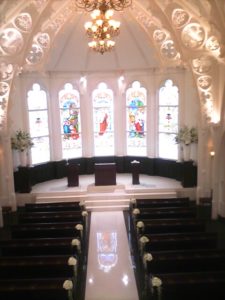
wedding hall cathedral
There is a general pattern to the chapel wedding, though options are of course readily available. Most couples and their immediate families show up a few hours before the ceremony dressed casually and spend the first hour, or so, being dressed and groomed by the hall’s staff. About an hour before the ceremony, the couple comes into the chapel for photos.With the doors closed, the parents are then lead to the chapel for a small ceremony that gave wedding halls fits trying to name. Because the image Japanese people have of Christianity is as a foreign, western religion, things must have foreign, or foreign sounding, names. What is about to happen when the chapel doors open is that the parents will see their children dressed in wedding clothes for the first time. Sticking with the western theme, this has come to be called “First Meet.”
Following the first meet is a brief rehearsal for the bride and groom. Typically for Japan, and an example of adaptation, is the fact that the bride and groom are always called the groom and bride, and everything that happens, including the pastor greeting the parents, happens in that order. Always men first. The family introduction comes next with the respective families being introduced to their counterparts by the head of the household. This usually includes grandparents, aunts and uncles, and cousins. Having been properly introduced, the families pose for a group photo, most often in the chapel or in front of it. Then the “sacred” virgin road is roped off and the guests are seated with the bride’s guests on the left, when facing the front of the chapel, and the groom’s guests on the right.
The groom and pastor enter,sometimes with the groom stopping along the way so his mother can put a boutonnière in his lapel (naturally called the boutonnière ceremony.) The pastor normally climbs a few steps to a dais with some type of altar, a place for the rings and another place for the wedding certificate. After the introduction from the pastor comes another Japanese innovation, the chapel movie. When I had my training sessions for being a wedding pastor, it was often pointed out that the bride is the star of the ceremony and a successful wedding will make the couple feel like they have been in a movie. The chapel movie is a series of snapshots of the bride from childhood to the present with captions that usually express her appreciation to her parents and family. Most often the movie ends with a picture of the groom and bride together that acts as a segue for the bride’s big moment.

and this is from the outside !
Chapels can vary quite a bit, from the Las Vegas, to the Mediterranean, to the Disney Castle, to the understated, but all have a focal point where the bride enters. Some have such lavish entrances that anyone would get the jitters just preparing to enter. When the doors spring open, the bride enters accompanied by her father, or other relative, and often stops at the beginning of the virgin road for the “Veil Down Ceremony,” where her mother pulls her veil over her face. It looks a lot better than I make it sound, especially in a church where the doors open onto a lot of green and the chapel lights are dimmed to let in the outside light, giving a genuine glow to the scene. Father and bride proceed up the virgin road until “The Baton Touch” where the father hands the bride to the groom.
Having ascended the dais, the couple joins with the congregation in a hymn. What westerners know as “What a Friend We Have in Jesus” is by far the most popular and apparently almost all Japanese know the melody. The scripture reading is also standard with Paul’s first letter to the Corinthians, chapter 13(Love is patient, love is kind …)always being read. A short sermon, usually written by a minister who is considered “real” and working for, or the owner of, the agency that sends the pastor and musicians, is delivered and either proceeded, or followed, by a prayer. This leads to the vows, which are also fairly standard, a Japanese translation of “in sickness and in health, etc.,”. The language that the pastor uses varies somewhat, depending on how foreign an impression the wedding hall wants to make. Some places use only a foreign language with English and French being most common, leaving guests completely bewildered but feeling like they have, indeed, experienced something foreign. Some pastors repeat everything in both their native language and Japanese, making for really long weddings, and some of us, mercifully, are allowed to do the ceremony in Japanese with just a sprinkling of English to keep people on their toes. “You may now kiss the bride” is a very popular place to use English, but also fails spectacularly when the nervous groom doesn’t understand what the pastor has said. I’m really lucky in that the places I work are happy to have just a benediction in English to satisfy the craving for foreignness, while making most of the ceremony intelligible to everyone. A few chapels have requested we try to pronounce Japanese in a foreign way, though.
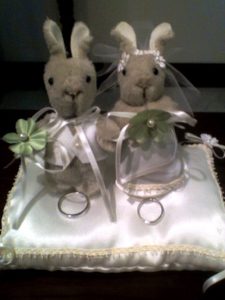 On to the ring exchange and the main place where couples can really express themselves. A really popular part of most weddings now is having the ring delivered to the front by a child, a dog, a robot, or even a turtle, once. Children are most popular and arrive in a number of ways (infants are sometimes strapped into remote controlled car models) and costumes. The ring pillow is another chance for expression and is often hand made by the bride’s friends or relatives. Many are really beautiful and many are cute. Stuffed animals and Disney themes are common. The groom raises the veil and kisses the bride, sometimes with applause from the guests. Then another Japanese innovation as the couple place their hands on the bible (the result of too many courtroom drama scenes in movies ?) and the pastor recites a prayer. The pastor declares the couple a couple and then they sign a completely meaningless marriage certificate, often written in English, French or Italian, which is always beautiful and must make a great decoration for the home. A short benediction and maybe another hymn and the couple makes their exit. It’s very popular lately to have children, usually girls, hold up the bride’s train as the couple exits. Guests are given flower petals to shower the couple with.
On to the ring exchange and the main place where couples can really express themselves. A really popular part of most weddings now is having the ring delivered to the front by a child, a dog, a robot, or even a turtle, once. Children are most popular and arrive in a number of ways (infants are sometimes strapped into remote controlled car models) and costumes. The ring pillow is another chance for expression and is often hand made by the bride’s friends or relatives. Many are really beautiful and many are cute. Stuffed animals and Disney themes are common. The groom raises the veil and kisses the bride, sometimes with applause from the guests. Then another Japanese innovation as the couple place their hands on the bible (the result of too many courtroom drama scenes in movies ?) and the pastor recites a prayer. The pastor declares the couple a couple and then they sign a completely meaningless marriage certificate, often written in English, French or Italian, which is always beautiful and must make a great decoration for the home. A short benediction and maybe another hymn and the couple makes their exit. It’s very popular lately to have children, usually girls, hold up the bride’s train as the couple exits. Guests are given flower petals to shower the couple with.
Many chapels have a bell for the couple to ring and a place for the bride to throw her bouquet, though it’s usually a special throwing bouquet and not the one she carries during the ceremony. The groom may throw broccoli to his pals, too, and it comes with a package of mayonnaise. I forgot to mention that a shower of soap bubbles made by specially built bubble machines is often part of the exit, but that’s the basic show, err, ceremony.


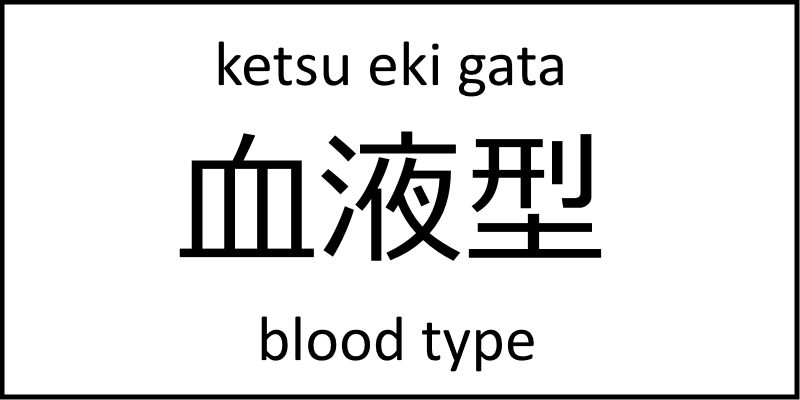
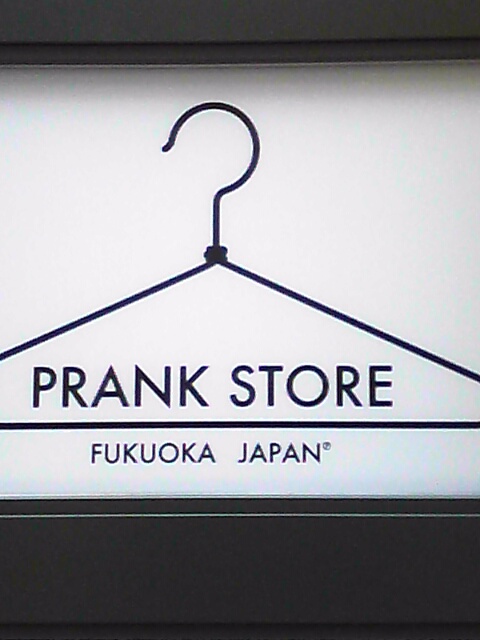
Comments
If you are lucky enough to be invited to a wedding, go. It is a great experience and a lot of fun. Even if you don’t understand Japanese perfectly, you will enjoy the day’s events.